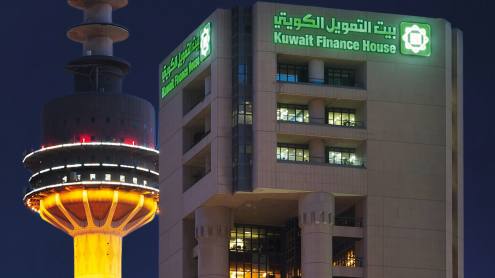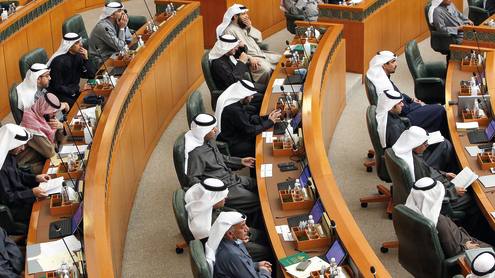Q: What is the central bank’s expectation for economic growth in 2021/2022?
A: The economic outlook is clouded by heightened uncertainty at present, as we are still in the midst of the pandemic. The recent resurgence in the spread of the virus in Kuwait [from early March] has resulted in a partial curfew scheduled to last until the beginning of April at the earliest. While the arrival of vaccines and the drive to inoculate the public, which is currently underway, has surely improved public sentiment and brightened economic prospects, it will take time before things get back to normal, even if to a ‘new normal’.
While intensive lockdowns and the sharp drop in oil prices (and cuts in production) led to a contraction of oil and non-oil activity in the first half of 2020 in particular, we expect both to return to positive growth this year. Encouragingly, early monetary, prudential and fiscal policy interventions since the outbreak of the pandemic have ensured that the country’s productive capacity remains broadly unscathed, offering hopes of a swift recovery once the pandemic is brought under control.
Even parts of business sectors that are contact-intensive are adapting to changing operating conditions where possible, as the rise in online sales from restaurants suggests. The recent recovery in oil prices, which recently reached the highest level in well over a year, also augurs well for both oil and non-oil gross domestic product growth in Kuwait.
Q: What steps is the central bank taking to protect the banking sector in 2021?
A: We have already put in place a range of support measures to preserve the soundness and stability of our banks, in turn ensuring a steady supply of credit to firms and households during these testing times.
On the monetary policy front, we swiftly moved to slash our policy rate by a cumulative 1.25 percentage points during March 2020, bringing the rate down from 2.75% to 1.5%. That move alone saw our interest rates falling to record lows, which significantly eased funding conditions and the debt servicing burden for borrowers of all types.
At the same time, we also partially relaxed a range of prudential regulations to ease any potential liquidity constraints and to enable banks to continue playing their role as financial intermediaries. For instance, liquidity coverage and net stable funding ratios were reduced from 100% to 80%; maximum lending limit was increased from 90% to 100%; capital conservation buffer (2.5%) was released; and credit risk weight for lending to small and medium-sized enterprises was reduced from 75% to 25%.
Moreover, all customers affected by Covid-19 were allowed to delay payments by up to six months without any penalty. This measure alone directly helped the firms and individuals to survive the worst phase of the pandemic-induced economic contraction.
Given the aforementioned measures that we already put in place, I don’t anticipate a major policy shift during this coming year, as we aim to continue providing the necessary policy support, while being adequately flexible — by tailoring the response as we learn along the way and as economic conditions warrant.
And given the considerable uncertainty around the outlook, it goes without saying that we need to be vigilant of the developments and agile in our response.
Q: Is credit growth likely in 2021/2022, given the pandemic?
A: Domestic credit offtake in 2020 was healthy, recording 3.5% growth over 2019. Quite a few sectors posted double-digit growth in credit, including consumer loans (11.2%), public services (11.4%), and agriculture and fishing (15.2%), although the latter two were from a very low base. Other segments with noticeable growth included crude oil and gas (8.4%), instalment loans (6.3%) and real estate loans (3.5%) — the last two being the largest recipients of bank credit in general. As these numbers reflect, credit offtake was not only healthy but also fairly broad based.
We expect credit growth to remain healthy in 2021, as the impending rebound in business activity and potentially higher capital spending will boost demand for business credit. Household credit, with lending to citizens in particular, is also expected to stay upbeat, supported by job security and currently prevailing record low interest rates.
Q: What is the outlook for non-performing loans (NPLs)?
A: Notwithstanding the combined health, oil and economic shock triggered by the pandemic, and the consequent economic contraction, banks’ asset quality, on a consolidated basis, has witnessed only a marginal deterioration in 2020 — increasing by 50 basis points to reach 2%. Both payment holidays and extensive policy support measures have helped to keep delinquencies in check. Moreover, Kuwaiti banks entered the Covid-19 crisis from a position of considerable strength, with their coverage ratio of 271% and NPL rate at 1.5% by the end of 2019 — the lowest level in over a decade.
In the months ahead, additional formation of NPLs would not be unlikely, though it is expected to take place at a slower pace, in a lagged manner and from historically lower levels. In the end, it is the evolution of the pandemic and consequent length and depth of the crisis that will determine the degree and pace of infection in credit. Thankfully, our banks are in a comfortable shape to withstand this crisis; their current coverage ratio of 222% would provide a more than reasonable cushion to absorb any potential shock.
Q: What is the broad outlook for the banking sector, as coronavirus restrictions wind down?
A: In addition to the outlook for credit and NPLs, other financial soundness indicators also exhibit a reassuring picture. For instance, banks have maintained ample liquidity during the crisis, with coverage and net stable funding ratios reaching 184.2% and 114.3%, respectively, by the end of 2020, against the required benchmark of 100%. Regulatory liquidity has also been around 27.5% against the required 18% level. At the same time, our banks’ capital adequacy ratio has increased during 2020 to reach 19%, comfortably above the Central Bank of Kuwait’s (CBK’s) requirement of 13% or Basel’s benchmark of 10.5%. These indicators suggest that the banking sector has sufficient capacity to continue lending to firms and individuals in the months ahead.
Given the extremely challenging and highly uncertain economic environment, profitability unsurprisingly came under pressure last year. Payment moratoriums, a rise in provisioning expense and low interest rate environment have all weighed on profitability. However, once the restrictions are eased and economic activity gains momentum, pressure on operating returns could ease on the back of higher credit offtake, in part because of greater capital spending by the government. Lower interest rates, while limiting interest income, would also help keep debt servicing costs of borrowers lower, thus containing credit risk and associated loan loss provisions.
Although there is considerable uncertainty around the outlook, our banking sector remains resilient and well poised to benefit from the improved economic opportunities that the recovery would offer. The soundness and stability of our banking system is also corroborated by the results of our comprehensive stress testing exercise done recently.
Q: The central bank last year asked Kuwait Finance House to conduct further studies regarding the feasibility of its acquisition of Ahli United Bank. Have these studies been carried out?
A: In line with the decision of CBK’s board of directors on May 5, 2020, Kuwait Finance House was advised to conduct a comprehensive reassessment of the acquisition once the unprecedented conditions triggered by Covid-19 return to normal. As the pandemic continues unabated, it would be too early to start any reassessment exercise.
Q: What are the aims of the central bank’s recently launched ‘Diraya’ campaign?
A: CBK, in collaboration with Kuwait Banking Association (KBA) and the participation of all Kuwaiti banks, launched the ‘Diraya’ (Be Aware) campaign in late January this year.
The campaign aims to enhance financial awareness across all segments of our society by making the public better informed about what banks do and how customers can make best use of various products and services offered by banks. In that sense, it embodies our efforts to educate customers of their rights and responsibilities, as well as the protection that they enjoy through CBK’s consumer protection rules.
Diraya also addresses specific services provided to people with disability, grievance redress mechanisms, and means to avoid scams and frauds. Also covered are issues such as loan encashment and high-risk investments, to name a few.
In order to reach all segments and educate the public in a comprehensive manner, the campaign videos, press statements and various other media are being published and disseminated across all communications channels, especially across digital platforms as well as through CBK, KBA, and banks’ branches and social network accounts.













